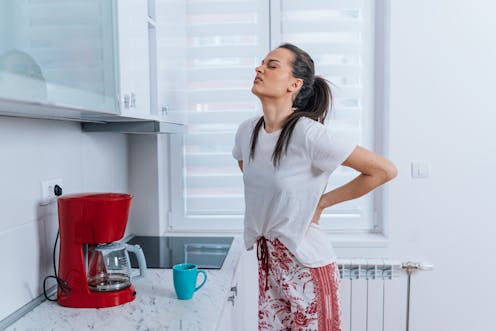
The Research Brief is a short take about interesting academic work.
The big idea
Low back pain is the leading cause of disability in the world, with over 600 million people living with the condition. This is one of the key takeaways of our June 2023 study published in the journal The Lancet Rheumatology.
Our systematic analysis synthesizes data from approximately 500 studies throughout the world over 30 years to estimate the global burden of low back pain, broken down by country, year, age, sex and severity. “Burden” refers to a combination of how common low back pain is and how much health loss it leads to. We measured low back pain from people age 5 onward.
Low back pain has ranked first among causes of disability for the last three decades. Back pain, however, is not inevitable, even if that sometimes feels like the case.
These findings are part of a larger project called the Global Burden of Disease Study, which aims to quantify all health loss globally.
Our study found that if society could directly address three major risk factors – obesity, smoking and workplace ergonomic factors – it could cut the burden of low back pain by 39%.
Smoking has been previously associated with damaged microcirculation of the spinal structures, for example, the discs and joints as well as to weakening of the bones. But researchers also know that smoking is often associated with other lifestyle factors, including physical inactivity, obesity and poor sleep, all of which have been linked to an increased risk of low back pain.
Similarly, obesity is associated with other unhealthy lifestyle factors, all of which can increase the risk of low back pain. Obesity is also linked to an increased load on the spinal structures, predisposing them to injury, and a systemic inflammatory response.

Why it matters
Low back pain is influenced by many factors, including biological, social and psychological. The anatomical complexity of the human spine means that in most cases, a simple structural cause such as a single joint or muscle cannot be identified, even with sophisticated diagnostic imaging.
This means that diagnoses are made largely on the basis of reported symptoms. And whereas most cases of low back pain are short-lived, with recovery experienced within the first six weeks of pain onset, one-third of cases will become persistent and may last for years. This persistence contributes to the significant burden of this condition.
As part of this work, we estimated how many people are likely to experience low back pain over the next 30 years if little changes. We predict that a whopping 843 million people around the world will be living with the condition. The problem of low back pain isn’t going away unless policymakers intervene.
Although a person’s sex does not directly determine the risk of low back pain, the condition is much more common among females. Our study found a global total of 395 million females reporting back pain, compared with 225 million males.
This discrepancy could be explained by differences in care-seeking behavior, as well as in access to health care, between men and women.
The rates of occurrence of low back pain also differ depending on how old you are. It is a common myth that low back pain is most common in working-age adults, but in fact rates are highest for people in their 80s. Older adults often are overlooked when it comes to care.
Older adults with low back pain have limited access to evidence-based treatments that encourage a healthy lifestyle and recovery, such as those that support patients to manage their own symptoms. They are also less likely to recover from severe pain and disability than their younger counterparts, are more prone to develop long-term, persistent symptoms and are at an increased risk of falls.
What still isn’t known
For those with low back pain, better and more effective ways are needed to manage it. Studies show that many current treatments either don’t work or do very little. These treatments include pain relievers and some surgical procedures.
Given our finding that hundreds of millions of people live with low back pain, it’s clear that more research is needed to identify effective preventive strategies.
The Global Burden of Disease Study is funded by the Bill & Melinda Gates Foundation.
Manuela Ferreira receives funding from the National Health and Medical Research Council of Australia, Medibank Research Foundation, NIHR-UK, and Finnish Academy of Science.
This article was originally published on The Conversation. Read the original article.







